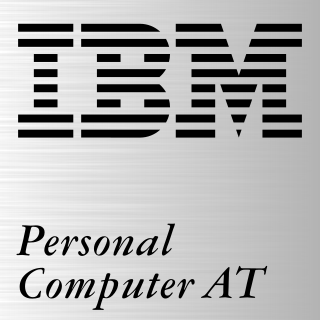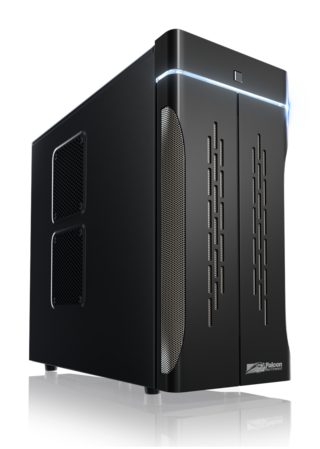
The IBM Personal Computer AT was released in 1984 as the fourth model in the IBM Personal Computer line, following the IBM PC/XT and its IBM Portable PC variant. It was designed around the Intel 80286 microprocessor.

In personal computing, a tower unit, or simply a tower, is a form factor of desktop computer case whose height is much greater than its width, thus having the appearance of an upstanding tower block, as opposed to a traditional "pizza box" computer case whose width is greater than its height and appears lying flat.

The Pivot is a family of early IBM PC–compatible portable computers first released in 1984 by Morrow Designs, a company founded by George Morrow. It was the first lunchbox-style portable computer, with a vertically configured case that has a fold-down keyboard. The only external component is a single AC adapter. It would have been a little top heavy except for the large camcorder-style battery loaded into its base. The Pivot was designed by Chikok Shing of Vadem Inc.

Irwin Magnetic Systems, Inc., also known as Irwin Magnetics, was a computer storage manufacturer active from 1979 to 1989 and based in Ann Arbor, Michigan. It was founded by Samuel Irwin in 1979 as Irwin International, Inc. The company's primary export was magnetic tape data storage and backup systems for personal computers. Irwin was one of the first companies to manufacture quarter-inch cartridge (QIC) systems for the personal computer market. In 1989, the company was acquired by Cipher Data Products.

Tecmar Inc. was an American manufacturer of personal computer enhancement products based in Solon, Ohio. The company was founded in 1974 by Martin Alpert, M.D., and Carolyn Alpert. The company's first products were computerized medical equipment; the company shortly after pivoted to data acquisition boards for the first generation of microcomputers. Popular products included the Scientific Solutions LabMaster series of boards for S-100 and Apple Computer.
The MBC-550 series, also known as the MBC-550/555, is a series of personal computers sold by Sanyo. It was unveiled at the COMDEX/Spring '83 in April 1983 and first released to market in March 1984. All models in the MBC-550 series featured pizza-box-style cases and Intel 8088 microprocessors and run versions of MS-DOS. On its release in 1984, the MBC-550 was the least expensive IBM PC compatible released to date, at a price of $US$995. The MBC-550 series followed Sanyo's MBC-1000 line of CP/M computers.

The IBM Personal Computer XT is the second computer in the IBM Personal Computer line, released on March 8, 1983. Except for the addition of a built-in hard drive and extra expansion slots, it is very similar to the original IBM PC model 5150 from 1981.

Reply Corporation, often shortened to Reply Corp., was an American computer company based in San Jose, California. Founded in 1988 by Steve Petracca, the company licensed the Micro Channel architecture from IBM for their own computers released in 1989, competing against IBM's PS/2 line. The company later divested from offering complete systems in favor of marketing motherboard upgrades for older PS/2s. Reply enjoyed a close relationship with IBM, owing to many of its founding employees, including Petracca, having worked for IBM. The company was acquired by Radius in 1997.

The Personal System/2 Model 30 and Personal System/2 Model 30 286 are IBM's entry-level desktop computers in their Personal System/2 (PS/2) family of personal computers. As opposed to higher-end entries in the PS/2 line which use Micro Channel bus architecture, the Model 30 features an Industry Standard Architecture bus, allowing it to use expansion cards from its direct predecessors, the PC/XT and the PC/AT. The original PS/2 Model 30 is built upon the Intel 8086 microprocessor clocked at 8 MHz; the Model 30 286 features the Intel 80286 clocked at 10 MHz.

The Personal System/2 Model 25 and its later submodels the 25 286 and 25 SX are IBM's lowest-end entries in the Personal System/2 (PS/2) family of personal computers. Like its sibling the Model 30, the Model 25 features an Industry Standard Architecture bus, allowing it to use expansion cards from its direct predecessors, the PC/XT and the PC/AT—but not from higher entries in the PS/2 line, which use Micro Channel. Unlike all other entries in the PS/2 line, the Model 25 and its submodels are built into an all-in-one form factor, with its cathode-ray tube (CRT) monitor and system board occupying the same enclosure. IBM oriented the Model 25 at home office workers and students.

Aox Inc. was a privately run American technology corporation founded by Michael and Linda Aronson in 1978. Over the course of its 22-year lifespan, the company chiefly developed software and hardware for IBM's PC and compatibles, for the Personal System/2, and for the Macintosh. In its twilight years, the company designed multimedia and teleconferencing devices and chip designs. Aox was founded after Michael Aronson graduated from Harvard University with a doctorate in physics; he stayed with the company until 2000, when he incorporated EndPoints Inc. and switched to full-time fabless semiconductor design.

Cumulus Corporation was an American computer peripheral and system manufacturer active from 1987 to 1993. Based in Beachwood, Ohio and started by Tecmar founder Martin Alpert, the company set out to exclusively manufacture expansion products for IBM's Personal System/2 (PS/2) family of computers—mainly RAM expansion cards. It later released cross-platform CPU upgrade cards and memory expansion cards for other platforms besides the PS/2. Beginning in 1990, the company began trading as Cumulus Computer Corporation and began releasing complete systems of their own. Initially a success story for the tech industry in Cleveland, a botched stock launch in 1992 proved disastrous for the company's ailing cash flow situation, and in 1993 the company was liquidated amid massive debt to suppliers and lenders.
CoreCard Corporation is an American financial technology company based in Norcross, Georgia. Before 2021, the company was named Intelligent Systems Corporation and once sold portable computers, video terminals, expansion cards, and other peripherals through a variety of manufacturing subsidiaries. Founded in 1973, the company restructured as a master limited partnership in 1987, becoming Intelligent Systems Master Limited Partnership.
Video Seven, Inc., also typeset as Video-7, later Headland Technology, Inc., was a public American computer hardware company independently active from 1984 to 1989. The company manufactured expansion cards for personal computers, mainly graphics cards for the IBM PC through their Vega brand. It was founded by Paul Jain as his second venture in the graphics card market; after his departure in 1990, he founded Media Vision. Video Seven delivered both the first graphics card compatible with IBM's Enhanced Graphics Adapter (EGA), in 1985, and one of the first cards compatible with IBM's Video Graphics Array (VGA) standard, in 1987. In 1989, Video Seven merged with G-2 Inc., a subsidiary of LSI Logic Corporation, becoming Headland Technology.

Vadem Inc., later Vadem Limited, was an original design manufacturer, chipset designer, and computer design firm active from 1983 to 2013. The company chiefly focused on the design of mobile computers such as laptops, rendering their services to companies such as Zenith Data Systems, Osborne Computer Corporation, and Sharp Corporation, among others. In the late 1990s, the company released their own branded product, the Vadem Clio, a PDA.
Apparat, Inc., was an American software developer, peripheral manufacturer, mail order company, and retailer active from 1978 to 1988 and primarily based in Denver, Colorado. They are best known for NewDos/80, an alternative operating system to TRSDOS for Tandy Corporation's TRS-80 line of home computers, sold through their Radio Shack stores. Apparat themselves sold modified TRS-80s through their mail order catalog. The company pivoted to selling peripherals for the IBM Personal Computer in 1982, continuing in this market until Apparat went defunct in 1988.

Jonos International, Inc., originally Jonos, Ltd. (JL), later Netcom Research, Inc., was an American computer company active from 1980 to 1992. The company sold a variety of computer hardware products and systems, including STD Bus peripherals, smart terminals, microcomputers, and portable computers. The company's Courier portable computer was the first microcomputer sold with Sony's then-new 3.5-inch floppy disk drives on its release in June 1982. Jonos' systems were widely used in the fields of construction, roadworks, machining, and military.
Xebec Corporation, formerly Microcomputer Systems Corporation, was an American computer hardware company active from 1969 to 1990. The company was primarily known for their data storage products, especially their hard disk controller ICs. A major customer of Xebec was IBM, who used their disk controllers extensively in the PC XT in 1983, their first PC with a hard drive preinstalled.














